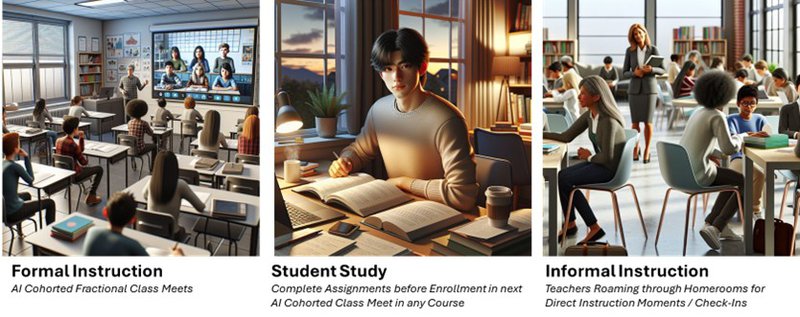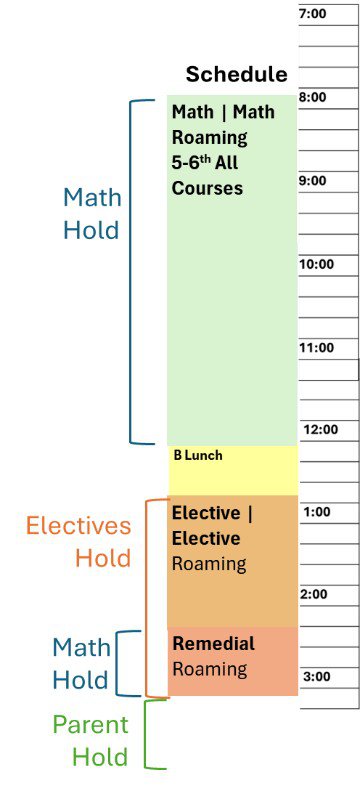Summary;
- Satellite Lounge schooling changes and gains
- Time AI as a solution
- Key concepts
- Budget hypothetical
Stop closing schools -- close your budget gaps. Consolidation to central locations is unworkable for many families and increases the total losses a district will have in enrollments. More distance and larger is the opposite of what parents want according to consumer research which even has formal schooling itself deconstructing as an idea into internet searching or AI chatbotting for “teach me Algebra.” Yet there is still strong support for more human teaching. The solution for districts having to consolidate is the transformation of under-enrolled schools to satellite “lounge” schools.
The satellite school is not the traditional whole group model with one teacher in every one classroom. It is best pictured as a multi-grade learning “lounge” and also works well as a charter or microschool.
What changes:
- Master Schedule adaptation so that Time AI syncs the satellite students to your central schools.
- Satellite school space use -- keep a fraction of it and use fewer staff, perhaps reallocating some to new or expanded multi-school course offerings.
- Teacher time use and mobility -- teachers rotate out to satellites.
- Learning becomes course-centric, not classroom-centric, with hybrid live classes every time.
- Every “class” is on-demand, shorter and smaller, set by the AI based on cohorts accumulating to those points in a course.
Gains:
- Compete with alternatives by offering highly flexible schedules, greater breadth of curriculum, personalization of both path and pace, and the less formal feel sought after by families.
- Staff cost reduction through leveraging their professional work while they do less administrative work -- but in a time when teachers and substitutes are hard to find anyway.
- Surplus capacity to reinvest in equity, innovation, and long-term sustainability

The public narrative suggests that school choice and homeschooling are the inevitable future. By 2030, government schooling is projected to account for just half of all K–12 learning unless major changes are made to our traditional schooling structures. Learning Counsel discusses the real why of this is not bad schools, it’s a change in culture with expectations of learning delivery being entirely personalized on many meaningful structural points that just can’t be done in the whole-group model.
Parents and students want learning that meet individual needs—without sacrificing live teaching and socialization. Yet our current structure, built on rigid age-based cohorts and linear schedules, cannot deliver this. It was designed for a manufacturing era, not a dynamic, personalized future that is technologically sophisticated while paradoxically interested in hand-crafted everything. The outdated schooling model perpetuates inequity and forces educators to fight against the grain, continuously trying every new method, theme and tech, doubling their workload just to keep up.
The Time AI Solution
Imagine a new schema where AI-driven calendaring and auto-cohorting reorganize learning patterns. The schema is called PathFlex Logistics and uses Time AI to change almost everything about how time and space is used across wider geographies of school buildings and staffing. Time AI has a baseline of AI functions and learns from how time is used, which is a different set of information than language or numbers as is used in Generative AI. It restructures schooling around perpetually open, pace-based courses, integrates fractional teaching time, and uses classrooms as flexible meeting spaces. This approach enables true personalization while preserving human interaction and community—something purely virtual models cannot achieve.
This is not a distant vision; it just awaits adoption at scale by schools and districts who truly need to restructure. It’s a practical, actionable framework that districts can implement now to stop closures and stabilize enrollment.
Key Concepts
Time AI is a new logistics innovation for schooling that allows every class moment to be set dynamically. A class moment is an invitation that is accepted after the student completes prior study of any kind and enrolls. The class sets itself with the teacher once it accrues a full cohort, the size of which is set by the teacher to be anywhere from 1-100 students. This innovation was born out of the pandemic when most schools realized a full hour of virtual meeting is unworkable even if it is desirable to have live teaching happening.
Fractional teaching means separating the normal hour of class time into its three natural parts of formal live instruction of any method, independent study done in separated spaces, and informal instruction while roaming. It is the fractionalizing of the teacher’s verbalization moment into multiples, usually shorter, that allows for the total transformation.

Course centricity and not classroom-centricity is a change in both where the students and teachers are physically at any moment, and also the teacher or district’s curriculum build. Being course centric is so that learning is all pace-based and can use AI-cohorting schedules to distribute students across time by their own pace to have their class meetings with teachers. Time AI helps teachers manage pace where needed with overrides and flagging.
Part of the existing block schedules, or all of the learning is set up to run by assigning a course to a student which has a teacher but uses togetherness-time and spaces dynamically. Again, this is different than assigning a student to a course/classroom and specific hour on the schedule. Pilots can run at a smaller scale.
Space use shifts to large homerooms, especially in the satellites. These are quiet-zone and out-loud zone study spaces set up like lounges that one or two paraprofessionals or adults can oversee. A couple of mini-classrooms nearby and/or glass-partitioned spaces with large video conferencing half-moon tables with screens are the new “classroom” virtual link to remote teaching as class moments are set on the calendars. While at the satellite doing live teaching, the students on a main campus are now attending virtually and so forth.
AI Holds

An AI “Hold” is an individual’s open bracketed time with a start and an end plus a label. It may also have inside itself one or more minus times, which is time within that block when the individual is not available such as breaks or lunch.
For example, a teacher may set a Hold and label it “Math.” It may start at 8:00 am and go to 3:15 pm, minus the time from 12:15-2:30 pm for lunch and a different elective subject.
That Hold, labeled “Math” for selecting when making an AI class Meet may be the time allowed for all the teacher’s math units for two grades, perhaps some 150 students on various courses, to drop into for the day.
Another Hold labeled “Elective” brackets the time for that subject’s AI class Meets to fall into.
A “Parent” Hold is the label selected on the appointment setting interface that a teacher can share a link to for parents to use if they need a meeting.
A “Hold” is an exclusive invention by the platform built by Knowstory and is part of “bi-level” AI calendaring.
Infinite Schedules within Master Schedule
Being able to set up a master schedule that has start/end of a year and within itself brackets by weeks, then days including by types of day (virtual, on-campus, remote, etc.), tracks and blocks is essential for school time management to achieve a fully flexible matrix of shared human resources and time. A major difference needed was being able to get to “infinite” schedules within a schedule, that is, having groups who all have the same schedule all the way down to individuals having independent schedules that are still fit within the larger schema of the master schedule -- perhaps longer hours in one subject than another, etc. This allows personalization of time for individuals. While it is hard to grasp this level of complexity to time use being run by AI, that is precisely why it has not been done before. The human complexity of managing all the moving parts of people and resources and buildings is hard, so it defaulted to whole-group one-teacher-per-classroom models and block schedules.
Budget Shift
Here is a hypothetical example in a small district of under 4,000 students of not closing two remote schools and instead shifting them into hybrid “satellite lounge” schools.
Space trimming and rearranging the underenrolled schools into hybrid “lounge schools,” where students engage in independent study, live or optionally virtual attendance, and AI-supported learning in flexible homeroom-style environments. Teachers rotate weekly to provide live teaching and mentorship. The remaining space—up to 75% of each site—can be leased to nonprofits, early childhood programs, or civic organizations.
Estimated impact:
- Operational savings: $1.8M
- Rental revenue: $1.2M
- Subtotal: + $3M
Software Rationalization & AI Integration
Conduct a district-wide audit of software and courseware. Retire redundant platforms and reinvest in enterprise AI and Time AI to generate curriculum, personalize pacing, and reduce content development costs.
Estimated impact:
- Software savings: $1.5M
- AI investment year 1 – including all consulting and training: $450K
- Net savings: + $1.05M
Staffing Realignment & Role Redesign
Reduce staffing by 35% across all schools in the district (not necessarily teachers), with retraining pathways for remaining educators to become AI-augmented facilitators, roaming mentors, and curriculum curators. Lounge schools require fewer full-time staff and more flexible, empowered roles. Alternately redeploy staff into changed roles and expanded curriculum offerings which recapture lost students causing approximately the same net savings with no staff reduction.
Estimated impact:
- Staff reduction savings: $7.35M or Regained Enrollment with no reduction
- Retraining and transition support: $2M
- Net savings: + $5.35M
Total Estimated Recovery: + $9.35M
Stop Closing Schools
Trends research indicates that the sharp rise in alternative schools and homeschooling is an avalanching trend, and the reason why is human interaction. The idea of satellite lounge schools is the solution using AI to be more human with purposefully set live interaction, not routines. The entire schema injects an experiential event element to learning that whole-group linear schedules barely did.
The ideal of PathFlex learning logistics utilizing Time AI can be the difference between a district that survives—and one that leads the future of education.
***











